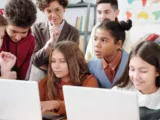What would be the best idea for an online meeting platform? In the classroom, video conferencing is the method of choice for conducting lessons, small group and one-to-one classes, tutorials, meetings, and more.
Still, if you’re using video conferencing in an educational setting, there are some basic etiquette rules you should follow to get the most out of it.
Online teaching is one of the ways schools can generally benefit from video conferencing software.
Like many parts of our way of life, education has undergone major changes over the years and has been redefined for a new era. Once virtual education becomes niche or offered to complement face-to-face education, it will go mainstream.
So new tools are being used in the classroom, such as video conferencing as a teaching method, small group and his one-on-one classes, tutorials and conferences. The introduction of video conferencing in education has several important advantages. Combining courses with other online educational activities and opportunities can make education more accessible.
Many students and teachers agree that learning can be more engaging and participatory if they can effectively access video conferencing during class. How does video conferencing in class work? Characteristics of video conferencing in education.
Video conferencing enables students and teachers to connect with each other using the same technology that businesses and other organizations use for video conferencing. This typically requires video conferencing software, a device (such as a mobile phone or laptop) to run the software, and an online connection.
Once the basic requirements are in place, students and teachers can participate in classes, small group work sessions, tutorials, and other educational events to see, engage, and connect with teachers and classmates. I can. Who Uses Video Conferencing for Education?
There are many ideas and uses for video conferencing to connect with people in educational institutions and even some people in your organization who can benefit from being able to meet in person from anywhere.
What is video conferencing used for?
An obvious use of video conferencing in education is for individuals to participate remotely to broadcast classes and lectures to students.
However, online courses are just one of the many ways schools typically benefit from video conferencing software. Other great uses include:
Working time:
Office hours have always been a real way of facilitating informal conversations between students and teachers or teaching assistants. Video conferencing makes it easy to broadcast drop-in concepts online and set up office hours where students can log in to chat and ask questions.
Instruction time:
Providing tutoring and other support in a virtual environment can make these tools more accessible and improve students’ ability to view these important resources.
Group discussions and projects:
Group work often serves as a reward for education, promoting collaboration, diversity of thought, and teamwork, among other benefits. Video conferencing solutions make it easier for children to get together and work together.
Faculty meeting:
Students and teachers aren’t the only ones who need to get together and share. Video conferencing enhances that ability. Video conferencing is also a great vehicle for faculty meetings, removing barriers that prevent staff from attending such meetings.
Teacher Conference:
Working as a lecturer also means learning, for example at conferences. Using the Internet and video conferencing technology for such events allows teachers to attend and learn, but reduces travel time and time away from class. Educators can attend virtual meetings even if they are unable to attend due to time or travel costs.


